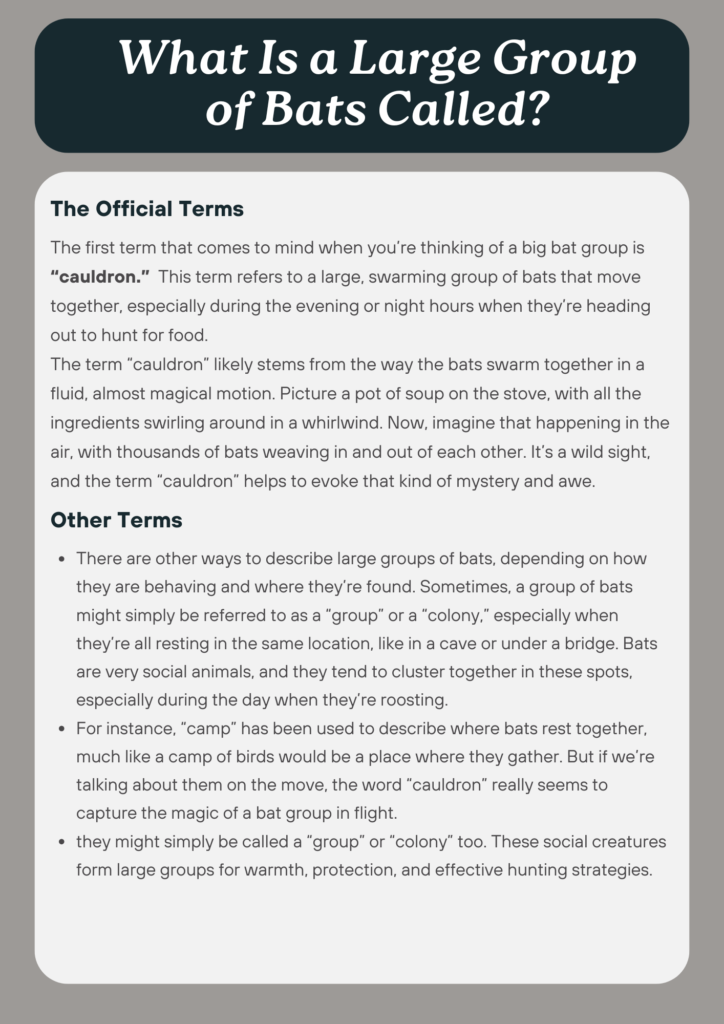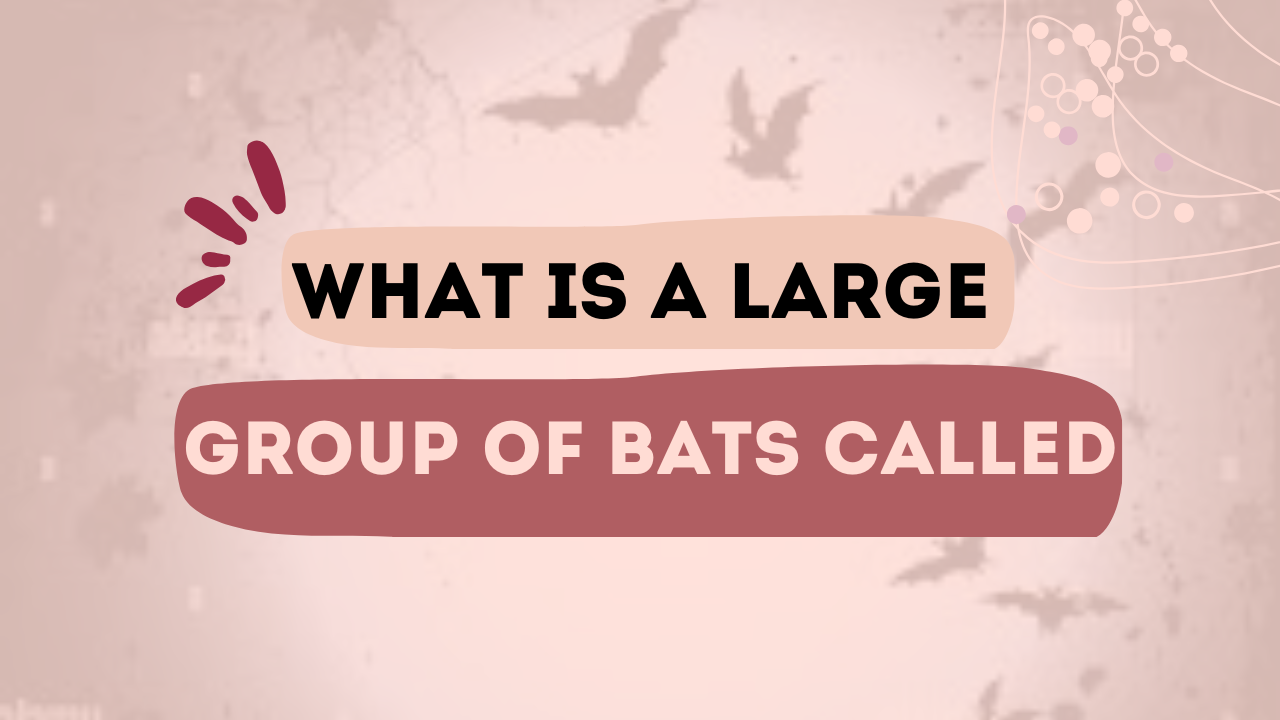Have you ever wondered what a large group of bats is called? Well, if you think it’s something like a “flock”, you’re not entirely wrong, but there’s actually a special term for them! Whether it’s a “cauldron,” a “cauldron of bats,” or just a “group,” there are several terms that could be used depending on the situation. In this article, we’re going to dive deep into what these terms mean, where they come from, and explore some cool facts about bats that you probably didn’t know.
Now, if you’re like me, you probably think about bats as spooky creatures that swoop around in the night, right? That’s what I thought growing up, anyway. But the truth is, bats are a lot more than just Halloween symbols or creepy critters hanging from cave ceilings. They’re incredibly important for our ecosystems, especially when it comes to controlling insect populations. So, what do we call them when they all come together? Well, it depends on the situation. There’s no one-size-fits-all answer, but we do have a few terms that are generally used to describe a large group of bats.
The Official Terms: “Cauldron” and “Cauldron of Bats”
So, the first term that comes to mind when you’re thinking of a big bat group is “cauldron.” Sounds pretty mystical, right? Like something out of Harry Potter! And yeah, there’s definitely an air of the supernatural when it comes to a “cauldron of bats.” This term refers to a large, swarming group of bats that move together, especially during the evening or night hours when they’re heading out to hunt for food.
Why “cauldron”? The term “cauldron” likely stems from the way the bats swarm together in a fluid, almost magical motion. Picture a pot of soup on the stove, with all the ingredients swirling around in a whirlwind. Now, imagine that happening in the air, with thousands of bats weaving in and out of each other. It’s a wild sight, and the term “cauldron” helps to evoke that kind of mystery and awe.
But, you know, there’s also the Halloween vibe that comes with it! A group of bats in flight can look spooky, and the cauldron reference just adds to that eerie image. So, next time you’re watching bats flying around at dusk, you might just think to yourself, “Wow, that’s one heck of a cauldron of bats!”
Other Terms: “Cauldron” Isn’t the Only One
Okay, so while “cauldron” is the most famous term, it’s not the only one. There are other ways to describe large groups of bats, depending on how they are behaving and where they’re found. Sometimes, a group of bats might simply be referred to as a “group” or a “colony,” especially when they’re all resting in the same location, like in a cave or under a bridge. Bats are very social animals, and they tend to cluster together in these spots, especially during the day when they’re roosting.
In the case of certain species of bats, they might also be described as a “cauldron” if they’re flying together in large numbers. But you might hear a few other terms as well—some more informal than others. For instance, “camp” has been used to describe where bats rest together, much like a camp of birds would be a place where they gather. But if we’re talking about them on the move, the word “cauldron” really seems to capture the magic of a bat group in flight.

Why Do Bats Form Large Groups?
Okay, so now you know what a large group of bats is called, but you might be wondering—why do they form such large groups in the first place? Well, there are a couple of reasons behind this behavior. First, bats are highly social creatures. They tend to form large colonies or groups to provide each other with protection, warmth, and companionship. It’s much safer for bats to roost together in large groups because there’s safety in numbers—especially when it comes to avoiding predators like owls, hawks, or snakes.
Another reason bats gather in large groups is to stay warm. Bats are mammals, and they’re cold-blooded, so they need to conserve heat to survive. By roosting together in large clusters, they can keep each other warm, which is particularly important in cooler weather. Some species of bats, like the little brown bat, may even huddle up closely to create warmth for themselves.
Lastly, there’s the fact that bats are incredibly efficient hunters when they work together. By flying in large groups, they can cover more ground while searching for food. They often feed on insects, and the more bats in the group, the more insects they can catch. This makes their feeding strategies more effective, especially in areas where food sources are abundant.
Fun Facts About Bats
Now that we’ve tackled the question of what a large group of bats is called, let’s take a quick detour into some bat facts that might just blow your mind!
- Bats Are the Only Mammals That Can Fly: Unlike birds, bats are the only mammals that have developed true flight. Their wings are actually a modified form of their forelimbs, with skin stretched between the bones. Pretty cool, right?
- Bats Help with Pollination: While most people think of bats as insect hunters, many species also play a vital role in pollination. In fact, some of the world’s most famous plants, like agave (used to make tequila), rely on bats for pollination.
- Bats Are Incredible Echolocators: Most bats rely on echolocation to find their way around, especially in dark environments like caves or forests. They emit high-frequency sound waves that bounce off objects, allowing them to “see” in the dark using sound!
- A Single Bat Can Eat Thousands of Insects in a Night: Some species of bats are voracious eaters, consuming up to half their body weight in insects every night. If you’re dealing with a bug problem in your garden, bats could be the perfect natural pest control.
- Not All Bats Are Blind: Despite the popular misconception, bats aren’t actually blind. Most species have excellent vision, particularly in low-light conditions, which helps them navigate during their nightly hunts.
Wrapping It Up
So, to answer the question: What is a large group of bats called? It’s usually referred to as a “cauldron,” but depending on the situation, they might simply be called a “group” or “colony” too. These social creatures form large groups for warmth, protection, and effective hunting strategies. Whether you’re lucky enough to see a cauldron of bats swarming through the sky or just learn about them from afar, there’s no denying how cool (and important) these flying mammals really are!

